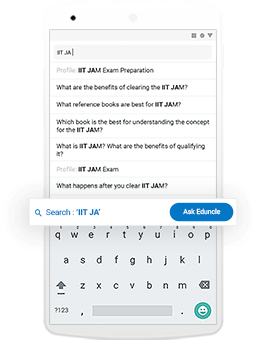Time management is very much important in IIT JAM. The eduncle test series for IIT JAM Mathematical Statistics helped me a lot in this portion. I am very thankful to the test series I bought from eduncle.
Nilanjan Bhowmick AIR 3, CSIR NET (Earth Science)
Suryaprakash posted an Question
- IIT JAM
- Biotechnology (BT)
What is difference between asymmetric and dissymmetric molecule..?
what is difference between Asymmetric and Dissymmetric molecule..?
- 0 Likes
- 2 Comments
- 0 Shares
-
![comment-profile-img]() >
>
-
![comment-profile-img]() >
>
Priyanshu kumar
![best-answer]()
A very simple example of an optically active compound would be CHFClBr: The two forms are mirror images and non-superimposable. Compounds like this simple example are said to possess "handedness", or more technically, are called chiral ("handed"). One of the forms will rotate plane polarized light to the left, the other to the right. The rotations will be in the same number of degrees. In organic compounds, optical activity is the result of at least one tetrahedral carbon atom which has four different groups attached to it. Such a carbon is known variously as a stereogenic center, a chiral center or an asymmetric carbon. Symmetric, Asymmetric and Dissymmetric molecules Symmetric molecules: If any symmetry is present in the molecule then molecule will be symmetric molecule. Dissymmetric molecules: Molecule will be a dissymmetric molecule if it has no plane of symmetry, no centre of symmetry and no alternating axis of symmetry. Asymmetric molecules: Dissymmetric molecule having at least one asymmetric carbon is known as asymmetric molecule. All asymmetric molecules are also dissymmetric molecules but the reverse is not necessarily true.
![eduncle-logo-app]()
Any doubt?
Do You Want Better RANK in Your Exam?
Start Your Preparations with Eduncle’s FREE Study Material
- Updated Syllabus, Paper Pattern & Full Exam Details
- Sample Theory of Most Important Topic
- Model Test Paper with Detailed Solutions
- Last 5 Years Question Papers & Answers
Sign Up to Download FREE Study Material Worth Rs. 500/-










 >
>
 >
>









Anup Padwal
A very simple example of an optically active compound would be CHFClBr: The two forms are mirror images and non-superimposable. Compounds like this simple example are said to possess "handedness", or more technically, are called chiral ("handed"). One of the forms will rotate plane polarized light to the left, the other to the right. The rotations will be in the same number of degrees. In organic compounds, optical activity is the result of at least one tetrahedral carbon atom which has four different groups attached to it. Such a carbon is known variously as a stereogenic center, a chiral center or an asymmetric carbon. Symmetric, Asymmetric and Dissymmetric molecules: Symmetric molecules: If any symmetry is present in the molecule then molecule will be symmetric molecule. Dissymmetric molecules: Molecule will be a dissymmetric molecule if it has no plane of symmetry, no centre of symmetry and no alternating axis of symmetry. Asymmetric molecules: Dissymmetric molecule having at least one asymmetric carbon is known as asymmetric molecule. All asymmetric molecules are also dissymmetric molecules but the reverse is not necessarily true.